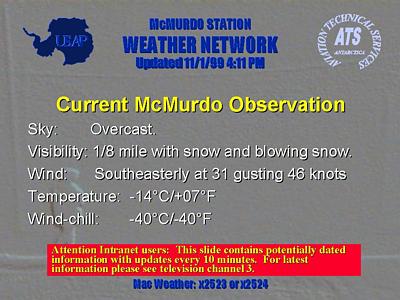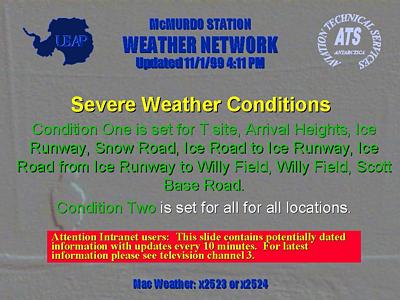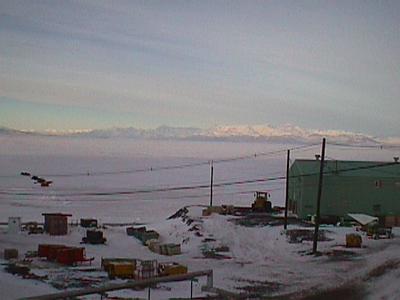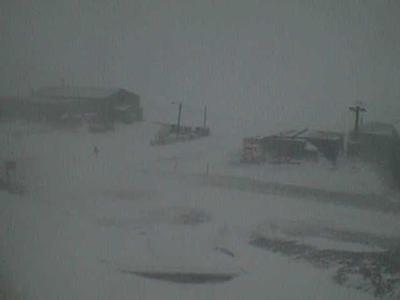1 November, 1999
Well, we finally got some weather. Antarctic weather and how.
Yesterday it clouded up and began to snow. This was the first falling snow I
had seen since I got here. There was less then an inch of accumulation of
the dry snow, but the wind is constantly blowing so the blowing snow causes
visibility problems and the drifts have to constantly be removed from the
roads. This morning the weather had deteriorated markedly so I paid a visit
to Mac Weather. I was told that an area of low pressure was over the
southern Ross Ice Shelf and is moving to the North. As this low-pressure
system moved closer, they thought the winds would increase. They were right.
As I looked at the satellite image of the low-pressure system, I was a bit
confused. It was showing clockwise rotation. Then I remembered that I was in
the Southern Hemisphere. Low-pressure systems, such as winter storms, rotate
in a counter-clockwise direction in the Northern Hemisphere. Here the
rotation is the opposite, with highs rotating counter-clock wise and lows
clock-wise. (In fact, I am very surprised I have not gotten any questions
about which way the toilets flush in Antarctica.) Once I made this
adjustment, I started to recognize the components of the storm system.
They have a system of classifying weather conditions here in order
to determine safe travel conditions. The conditions are classified as
condition One, Two, or Three. Condition ONE is when any one of the following
are true: Visibility is less than 100 feet; Wind is greater the 55 knots;
The wind-chill is greater than - 100 F. Condition TWO is when any one of the
following are true: Wind speed is between 48 - 55 knots; Visibility is less
than 1/4 mile but greater than 100 feet; The wind-chill is greater than - 75
degrees F but less than - 100 degrees F. Condition THREE is anything better
than condition TWO. In other words, Condition Three is the best weather;
Condition One is the worst. We have met the visibility criteria for
Condition Two (less than ¼ mile) in McMurdo and the visibility in some
places has dropped below 100 feet. Making it Condition One. (See notice
below.) We have also had wind gusts reported as high as 46 miles per hour.
Do we ever have Condition One weather in Wisconsin?
During a Condition Two, travel outside of McMurdo is limited. During
a Condition One, travel is not permitted. The road to Scott Base, the center
for the New Zealand Antarctic program, is under a Condition One. The Kiwi
scientists, including many of the people who work on the Cape Roberts
Project, have been stranded in McMurdo for the night The weather has also
prevented core samples to be flown by helicopter form the drill site, so
this has given all of the people in the lab a chance to catch up on the
backlog of samples. All in all, no one seems too upset by the weather caused
inconveniences. If you would like to see a polar-orbiting satellite image of
the Ross Sea area including Ross Island go to:
http://www.mcmurdo.gov/operations/weather/dailysat.html.
Another very exciting thing happened today. A New Zealand film crew
working for Fox TV was in the lab today. They are doing a special for
American TV on Antarctic research. They have been filming segments on much
of the research centered out of the Crary Lab. They took some of footage of
me processing samples in the palynology lab. Maybe you'll see me, or at
least my hands, on the Discovery Channel someday! Tomorrow I will tell you
all about my visit to Mac Weather and forecasting on the 7th Continent.

The current conditions at McMurdo as they appeared on the town-wide TV scroll.

The Condition One notice. The road to Scott Base is closed.

The view out of the window at Crary lab on a beautiful Condition Three day.

The view out of the same window approaching Condition Two.

The same view in a full-blown Condition Two, approaching Condition One.
Contact the TEA in the field at
.
If you cannot connect through your browser, copy the
TEA's e-mail address in the "To:" line of
your favorite e-mail package.
|
